The Development of the Oriental Breeds
The Development of the Oriental Breeds
New Breeds and their Recognition
In the early days breeds automatically had Championship status as soon as they were officially recognised by GCCF
as a distinct breed.
Breeds without Championship status competed in "Any Other Variety" classes. These classes contained not only the developing breeds who did not yet have Championship status, such as Foreign Lilacs and Foreign Whites, Cornish and Devon Rex, British Blue-Creams, Smokes and Tipped etc, but also new breeds at a very early stage of development and various cross-bred cats of no particular breed type or standard. All were registered as breed 26 - Any Other Variety. (The unrecognised Longhairs were registered as breed 13a and shown in an "Any Other Colour" class.)
From June 1977 the system was altered: breeds with Provisional recognition had their own Open classes, while breeds with only Preliminary recognition were judged in Assessment classes against their own Standard of Points.
The "breeds" without any Standard of Points at all vanished from the show scene (or remained unregistered and were shown in non-pedigree Household Pet classes).
The rules for the recognition of new breeds evolved: Intermediate Certificates were introduced for Provisional status breeds and breeds had to justify their promotion by demonstrating both their quality and quantity on the show bench. However, these rules did not allow for the addition of new colours to existing breeds and the numbers of "stray" colours of existing breeds proliferated in the Assessment classes.
In March 1995 a new set of rules was approved. These allowed the amalgamation of classes to provide more logical breed groupings and also allowed the inclusion of new colours in existing breed classes.
The Oriental Joint Breed Advisory Committee was then able to put forward a proposal to move the colours which had been "left behind" into the appropriate classes for their breed - eliminating the Oriental Non-Self Assessment class completely in the process! This was approved in October 1995 and took effect from June 1996.
The new rules also meant that when Apricot was accepted as an Oriental colour, with effect from June 1997, the Apricots could join their appropriate pattern classes.
What's in a Name ?
When the Oriental breeds were first recognised, the GCCF in its wisdom
decreed that the self breeds should be known as "Foreign" while the non-selfs became Orientals.
This caused some confusion: there were three blue Foreign breeds - Russian Blue, Korat and Foreign Blue, all quite distinct breeds. It was also difficult for novices to understand why one litter of kittens might contain Havanas, Foreign Reds and Oriental Torties, or Foreign Blacks and Oriental Tabbies. To add to the confusion, the Section in which these cats were shown was called the Oriental section and the judge list was known as the Oriental Self list!
The OJBAC believed that the confusion would be much reduced if, with the exception of the Havana and Foreign White, all Foreign Selfs became Oriental Selfs. The Havana breeders did not wish to change their name for historical reasons and all agreed that it should remain unaltered. The Foreign White breeders wished to retain their name for different reasons: Oriental Whites were accepted elsewhere with green eyes as well as blue, but Foreign Whites were essentially Siamese cats with white overcoats. As Foreign Whites could not be mated to other Orientals the OJBAC agreed to this exclusion as well.
So the proposal went to the February 1991 Council meeting ........ and hilarity broke out. Some delegates suggested that if any were to change, all should be changed, so the arguments for and against changing the Havana and Foreign White raged back and forth. Finally one bright spark from north of the border (a Longhair person with no interest in Orientals!) suggested that the names should be changed to Oriental Havana and Oriental Foreign White, the delegates hastily voted in favour of this to end the argument, and everyone ended up with two names that nobody wanted.
The OJBAC returned to the fray in October 1991 (there has to be a six month gap before an attempt to reverse a decision, so it could not go to the June meeting) and this time sense prevailed and the Havana and Foreign White reverted to their original names, while the other selfs remained as Orientals.
Havana
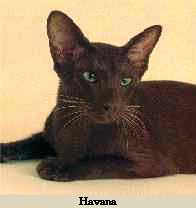 In the early 1950's when Chocolate Point Siamese were recognised, some breeders set out to produce a self chocolate Siamese-type cat,
starting by mating a Seal Point to a Russian Blue, then mating the black kittens back to Siamese. Before the brown results of this
breeding programme were produced, a mating between a half-Siamese and a Seal Point produced, by chance, a self chocolate cat, followed
by another from a repeat mating.
In the early 1950's when Chocolate Point Siamese were recognised, some breeders set out to produce a self chocolate Siamese-type cat,
starting by mating a Seal Point to a Russian Blue, then mating the black kittens back to Siamese. Before the brown results of this
breeding programme were produced, a mating between a half-Siamese and a Seal Point produced, by chance, a self chocolate cat, followed
by another from a repeat mating.
Some descendants of these early cats were exported to the USA and started the Havana Brown breed which retained the stockier type of its ancestors.
The breeders in the UK continued to develop the breed by mating to Siamese and, in 1958,
the "Chestnut Brown Foreign" was given Championship status by the GCCF. In 1970 the breed was renamed Havana,
the name the breeders had originally wanted.
Oriental Lilac
Because many of the cats used in the Havana breeding programme carried the dilute gene, lilac cats were also produced, as well
as blacks and blues. These other colours were shown in the AOV classes.
The Havana breeders worked to develop the Lilac, which was known as Lavender in its early days and achieved success at the same time as the AOV classes were abolished. The breed was promoted to Championship status in 1977, as the Foreign Lilac, and thus never appeared in Assessment classes.
Foreign White
Another group of breeders set out to produce a blue-eyed white Siamese-type cat by mating a Siamese out to a white shorthair
and then mating back to Siamese each generation until all the kittens produced were either Siamese or "Siamese in white
overcoats" with no unwanted genes present.
The Foreign White was shown in AOV classes from 1966 and proved very popular. It also gained GCCF Championship status in 1977.
Oriental Black
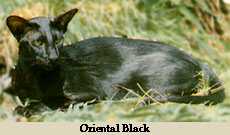 Blacks appeared regularly in the AOV classes over the years and were shown in the early Assessment classes.
They were granted Provisional recognition in April 1978 and actually had their own classes at the Short Haired Cat Society Show
a month later.
Blacks appeared regularly in the AOV classes over the years and were shown in the early Assessment classes.
They were granted Provisional recognition in April 1978 and actually had their own classes at the Short Haired Cat Society Show
a month later.
They were granted Championship status in April 1980, to take effect from June 1980.
Oriental Blue
Although blue half-Siamese were produced in the 1950's, when the Havana was being developed, they were registered as Russian
Blues in those days. Later the breeds diverged and Siamese-type Foreign Blues were shown in AOV classes and then in Assessment classes.
As with most dilute colours, the Blues appeared in smaller numbers than the Blacks and were slower to gain popularity. They were given Provisional recognition in April 1981 and Championship status in February 1985, with effect from June 1985.
Oriental Red
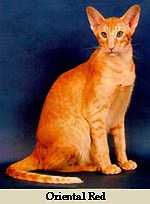 Although many were produced, Oriental Reds did not have the popularity of their Oriental Tortie litter-mates.
Some were shown in the AOV classes but they were not officially granted Preliminary recognition until 1984, although they
did appear in Assessment classes before then.
Although many were produced, Oriental Reds did not have the popularity of their Oriental Tortie litter-mates.
Some were shown in the AOV classes but they were not officially granted Preliminary recognition until 1984, although they
did appear in Assessment classes before then.
Their progress was not helped by Judges who tried to persuade exhibitors
to re-register their non-agouti reds as Tabbies, but eventually most people accepted that all Oriental Reds would show some
tabby pattern, even if it was ticked and appeared almost self. They gained Provisional recognition in June 1991 and Championship
status from June 1995.
Oriental Cream
Creams, too, appeared in AOV classes and early Assessment classes before their Preliminary recognition in 1984. However, due to
the small numbers being shown, they did not achieve Provisional recognition until 1994.
From June 1997 they have shared their Open class with Oriental Apricots.
The Creams and Apricots have increased in popularity and attained Championship status from 1st June 1999, still sharing a class.
Oriental Apricot
Although caramel has been an accepted Oriental colour for many years, apricot (produced by the effect of the dilute modifier
gene on cream) had not been recognised and Oriental Apricots were often incorrectly registered as cream.
In October 1996 the OJBAC proposal to recognise apricot as an Oriental colour was approved and in June 1997 the Oriental Apricot joined the Oriental Cream at Provisional status, sharing an Open class. With the Creams, they had Championship status from 1st June 1999
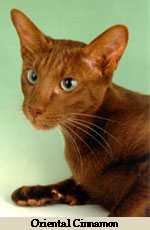
Oriental Cinnamon
Cinnamons were first produced in the UK in 1971,
from a brother-sister mating, the grandparents being a Sorrel Abyssinian (the source of the cinnamon gene which is
recessive to chocolate) and a Seal Point Siamese.
They won Merits in Assessment classes from 1980 onwards but
did not really get going as a breed until a breeders group was formed in 1986. Promoted to Provisional status from
June 1990, they achieved Championship status in June 1996.
Oriental Caramel
The Caramel colour, produced by the effect of the dilute modifier gene on a blue or lilac, was almost certainly introduced via the
Chinchilla. The early Caramels came from the Shaded breeding programme descended from a Chinchilla-Siamese cross,
while later Caramels trace back to Tabby Point Siamese lines. (One of the original Tabby Points was born very near
to a Chinchilla breeder!)
The Caramel self was given Preliminary recognition in 1983 but has never been a particularly popular breed, with few breeders intentionally breeding the self version although the Caramel Tabbies have proved far more popular and numerous. They achieved Provisional status in June 2004, and Championship status in June 2011.
Oriental Fawn
The Oriental Fawn, the dilute of the Cinnamon, was granted
Preliminary recognition in June 1989, together with fawn Torties, Smokes, Tabbies and Shadeds.
Like so many of the dilute colours, Fawns have not been as numerous as their dominant counterpart, but they achieved the qualifiers necessary to apply for promotion to Provisional status in June 1999 and to Championship status in June 2007.
Oriental Tortie
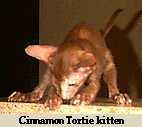 Oriental Torties were developed as a breed by mating Oriental Selfs to Red, Tortie or Cream Point Siamese and soon became popular.
The four colours which were recognised at that time - black, blue, chocolate and lilac - were granted Provisional recognition from
June 1984 and Championship status from June 1989.
Oriental Torties were developed as a breed by mating Oriental Selfs to Red, Tortie or Cream Point Siamese and soon became popular.
The four colours which were recognised at that time - black, blue, chocolate and lilac - were granted Provisional recognition from
June 1984 and Championship status from June 1989.
Cinnamon Torties were granted Preliminary recognition in 1986, Caramel Torties in 1987 and Fawn Torties in 1989, although few were ever shown in Assessment classes.
From June 1996 these colours were amalgamated with
the other Oriental Torties in a single Championship status class.
Oriental Smoke
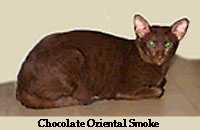 Initially produced from Silver Tabby and Shaded breeding, Smokes were shown in AOV classes and continued to be shown in Assessment
classes, but in small numbers. As the Smoke Standard of Points always permitted all Oriental colours, new colours were added as
soon as they were accepted for the other Oriental breeds.
Initially produced from Silver Tabby and Shaded breeding, Smokes were shown in AOV classes and continued to be shown in Assessment
classes, but in small numbers. As the Smoke Standard of Points always permitted all Oriental colours, new colours were added as
soon as they were accepted for the other Oriental breeds.
Smokes eventually achieved Provisional recognition from June 1995
and were joined by the Apricot Smokes in June 1997. Since 1st June 2001 they have had Championship status.
Oriental Spotted Tabby
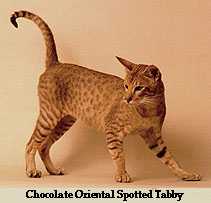 Spotted Tabbies had not really caused much excitement until 1970 when a stunning litter was produced from a mating between a Chocolate
Tabby Point Siamese and a Havana. The breed was initially developed under the name "Mau" and was shown successfully in AOV
classes.
Spotted Tabbies had not really caused much excitement until 1970 when a stunning litter was produced from a mating between a Chocolate
Tabby Point Siamese and a Havana. The breed was initially developed under the name "Mau" and was shown successfully in AOV
classes.
Like the Blacks, the Spotties had less than a year in Assessment classes, being granted Provisional recognition in April 1978 with their own classes in May 1978 under the name Oriental Spotted Tabby.
They also achieved Championship status from June 1980, but only in six colours: brown, blue, chocolate, lilac, red and cream. Although silver Spotties did exist, they were only at a very early stage in 1978, so were not included in the request for Provisional recognition. Caramel, cinnamon, fawn and tortie Spotties had not been recognised at all at that stage.
Cinnamon and cinnamon silver Tabbies were given Preliminary recognition in 1983 and tortie and tortie silver Tabbies (except cinnamon and caramel) in October 1985, followed by caramel and caramel silver Tabbies in March 1986. Cinnamon and caramel tortie and tortie silver Tabbies were recognised in September 1987 and Preliminary recognition of fawn, fawn silver, fawn tortie and fawn tortie silver Tabbies was approved in April 1989.
Provisional recognition of all of these other colours of Oriental Spotted Tabby was granted with effect from June 1990, giving a Championship status class and a Provisional status class split in a very strange way. However, from June 1996 the two classes were amalgamated to form a single Championship status class for all colours of Oriental Spotted Tabby, where the apricot and apricot silver Spotties joined them in June 1997.
Oriental Classic Tabby
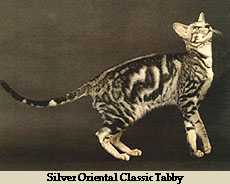 Classic Tabbies cropped up in Spotty litters where the parents carried the recessive classic pattern. A few breeders selected for this
pattern to develop the breed, but they were shown in Assessment classes for many years before being granted Provisional recognition
in June 1984. By this time, brown, blue, chocolate, lilac, red, cream and cinnamon and their silver versions had been recognised,
so these colours progressed together.
Classic Tabbies cropped up in Spotty litters where the parents carried the recessive classic pattern. A few breeders selected for this
pattern to develop the breed, but they were shown in Assessment classes for many years before being granted Provisional recognition
in June 1984. By this time, brown, blue, chocolate, lilac, red, cream and cinnamon and their silver versions had been recognised,
so these colours progressed together.
As each new colour was recognised in Classic Tabbies, as in Spotties, it joined the Assessment class - a strange assortment of caramel, fawn and tortie Classics and their silver versions.
In 1995 the OJBAC put forward a proposal to amalgamate the Classics, together with all colours of Mackerel Tabby and to promote
them to Championship status. This was approved, so all colours of Classic and Mackerel Tabby shared a single Championship status
class from June 1996, being joined by the apricot and apricot silver Classics and Mackerels in June 1997.
Oriental Mackerel Tabby
Oriental Mackerel Tabbies were granted Preliminary recognition in 1978 and had this confirmed when they were
allotted a breed number in 1984. The various colours were added to the Assessment class as they were recognised, but still very
few mackerel Tabbies were shown and only seven Merit Certificates were ever awarded.
It was obvious that, as in the British Shorthair section, Mackerel Tabbies would never be sufficiently numerous to warrant a class of their own, so the OJBAC applied, successfully, to amalgamate them with the Classic Tabbies in a single class.
Oriental Ticked Tabby
Ticked Tabbies were given Preliminary recognition in June 1984 in all the accepted Oriental Tabby colours.
By June 1989, when they were granted Provisional recognition, all colours except the fawn and apricot series had been recognised
and so progressed together, achieving Championship status from June 1993.
The fawn, fawn silver, fawn tortie and fawn tortie silver Ticked Tabbies were recognised in 1989 but few were ever shown and in June 1996 they were amalgamated with the main class, where they were joined by the apricot and apricot silver in June 1997.
Oriental Shaded
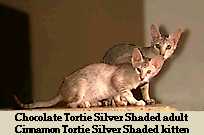 The first Oriental Shaded and Tipped were developed from a mating between a Chinchilla and a Chocolate Point Siamese,
the progeny being mated back to Siamese and Orientals to achieve the required type, and were granted Preliminary
recognition in April 1978. Recognition of the Tipped was confirmed in 1984 when they were given the breed number 46.
The first Oriental Shaded and Tipped were developed from a mating between a Chinchilla and a Chocolate Point Siamese,
the progeny being mated back to Siamese and Orientals to achieve the required type, and were granted Preliminary
recognition in April 1978. Recognition of the Tipped was confirmed in 1984 when they were given the breed number 46.
Although the Tipped was supposed to be much more lightly tipped with colour than the Shaded, on a short Oriental coat the distinction was somewhat blurred and in 1993 the two breeds were combined as a single breed - the Oriental Shaded.
As with the Tabbies, the colours were recognised progressively and when the Shaded achieved Provisional recognition in June 1995 the class included all but the apricot and apricot silver.
Despite taking so many years to reach Provisional
status, Oriental Shadeds were the quickest breed to progress to Championship status: there were ten 3-Intermediate Certificate
winners in less than a year, enabling their promotion to be approved in October 1996, with effect from June 1997, when they
were joined by the apricot and apricot silver Shaded.
Oriental Classes
Breed classes in the Oriental Section are as follows (all with Championship status):
Havana
Oriental Lilac
Foreign White
Oriental Black
Oriental Blue
Oriental Red
Oriental Cream and Oriental Apricot
Oriental Cinnamon
Oriental Caramel
Oriental Fawn
Oriental Tortie (all colours)
Oriental Smoke (all colours)
Oriental Spotted Tabby (all colours including silvers)
Oriental Classic or Mackerel Tabby (all colours including silvers)
Oriental Ticked Tabby (all colours including silvers)
Oriental Shaded (all colours including silvers)
Oriental Bicolour (all colours and patterns)
Oriental Longhair (all colours and patterns)
|
| These pages were brought up to date from the original by Julia May which is still accessible here:- |
Copyright, including logo, © 1997 - 2013 Oriental Joint Breed Advisory Committee. All rights reserved.